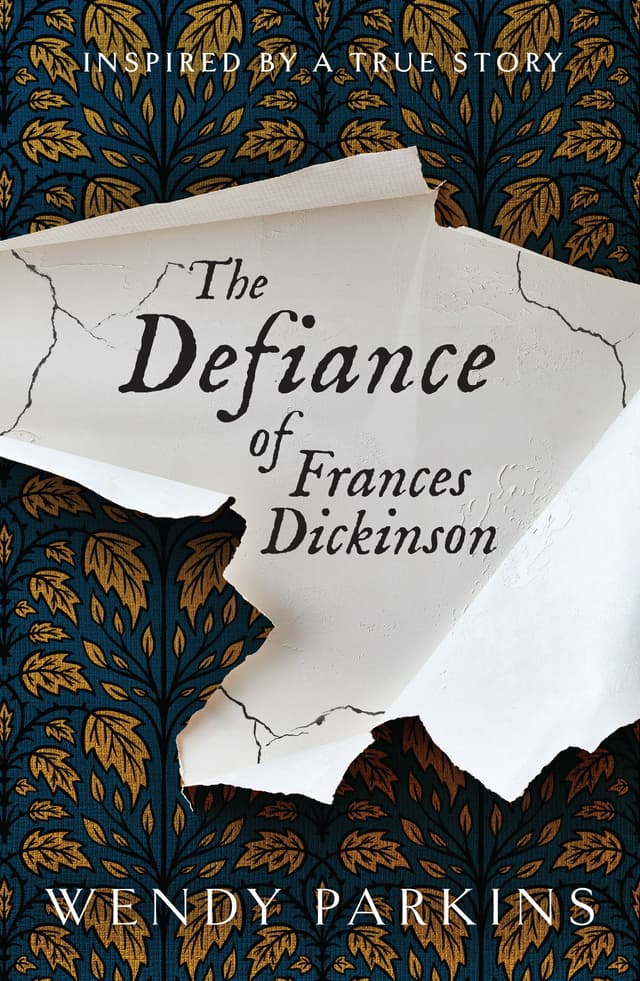Review: The Defiance of Frances Dickinson, by Wendy Parkins
Reviewed by Carolyn Cossey
Wendy Parkins’ novel The Defiance of Frances Dickinson is based on the life of a woman of privilege, a wealthy heiress, the titular Frances. It follows the course of her abusive marriage in England and Scotland during the mid-1800s and her subsequent fight for freedom. It has timeless themes, particularly that of coercive control and the modern term of gaslighting in its truest sense.
It starts with a visceral scene: Frances trapped in her childhood home, where she should be safe, with her own mother and servants present, but her husband is in the house too, as a menacing threat. She’s powerless, with no sovereignty over her own body, and the people who love her are unable to intervene. The physical nature of the abuse she suffers is explained delicately in her first-person narration, yet leaves the reader with no doubt of the extent. We get a sense of ongoing and long-term trauma and the fact that she is bound to this situation by fear for her children, that universal tactic to control women. She is about to act; the first chapter ends with her saying, ‘Oh my poor girls, we must take flight!’
Using an epistolary approach, the story moves back in time to explain how this toxic marriage has unfolded. Lengthy narrations by Frances and other key players are interspersed with shorter letters and diary entries by minor characters. To begin with, this requires close reading and some perseverance as it can feel disjointed. However, as the story progresses, the sense of these minor characters becomes established and the individual narrative threads begin to weave together. The divorce courts of the 1800s did not put the applicants of the witness stand for cross-examination but relied on written testimony. This gives a sense of rightness to the collection of writings; these snippets begin to form the body of evidence in Frances’ case.
The author also uses the occasional news or medical article as a device to reflect the general view of the time. Frances’ first pregnancy results in a miscarriage and this subject is introduced with an article about domestic medicine, which calls a miscarriage within the first month ‘False Conception.’ Introducing these viewpoints specific to the time, in a way that generally held little regard for women, builds the sense of gaslighting. Whose version on what is happening is true? Frances struggles with this too; to begin with her life isn’t all bad. After the first festive season in her new marital home of Scotland, complete with the exotic rituals of Hogmanay she reflects, ‘I feel blessed to be surrounded by loving folk who wish me nothing but good. How can I fail to be content with my life here.’
But the reader already has enough information to know Frances is kidding herself. Sexual notes are being passed between her personal maid and her husband. There is early friction with her sister-in-law, who writes an account labelling Frances as wilful and possessing a shrewish temper. The theme builds, what sort of woman is Frances, depending on who is viewing her?
Writing historical fiction is a hard choice, particularly so when the protagonist is a real person. Creating living, breathing characters from the historical record, that traceable footprint of thoughts and deeds, is difficult to achieve and requires inference and imagination. Parkins’ background as a professor of Victorian literature shows in the authentic feel of the characters’ voices throughout the novel.
The Defiance of Frances Dickinson is a thought-provoking book. Frances’ sensational petition for separation cited cruelty, adultery and unnatural connection. What sort of woman, it was asked, would even know of such things to make this accusation? It was a time when even a woman of wealthy means and resources was unlikely to be viewed sympathetically. The Defiance of Frances Dickinson is a potent reminder of how far women have had to travel to have basic rights upheld.
